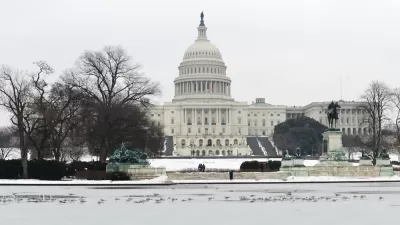A proposed Climate Planning Unit could help the federal government guide comprehensive climate policy and manage project costs.

A report from the Brookings Institution outlines suggestions for "how the White House can immediately kick-start climate solutions across our built environment through a new Climate Planning Unit (CPU)." The report suggests that the proposed office could "reduce the federal fiscal impacts of climate change by developing strategic intra-agency and cross-agency mitigation and adaptation projects and programs." By creating a federal office focused on climate change, the government can more effectively "identify opportunities (and outcomes) of effective climate action with direct and capturable federal financial benefits."
Federal investment in coordinated climate change policy has the potential to elevate climate concerns in development policies across the country, write Joseph W. Kane, Jenny Schuetz, Shalini Vajjhala, and Adie Tomer. "For instance, an 18F model can serve as a template for staffing, funding, and growing a new, dedicated federal unit focused on forward-looking research, metrics, and plans." The Blueprint developed by the Brookings Institution "supports the new high-level international and domestic climate leadership in the White House by establishing a stable basis for long-term, fiscally defensible, bipartisan federal climate action to complement other legislative and executive actions." The report also recommends a focus on "low-hanging fiscal fruit" that can help projects get off the ground faster and kickstart long-term efforts.
FULL STORY: How a federal Climate Planning Unit can manage built environment risks and costs

Alabama: Trump Terminates Settlements for Black Communities Harmed By Raw Sewage
Trump deemed the landmark civil rights agreement “illegal DEI and environmental justice policy.”

Planetizen Federal Action Tracker
A weekly monitor of how Trump’s orders and actions are impacting planners and planning in America.

The 120 Year Old Tiny Home Villages That Sheltered San Francisco’s Earthquake Refugees
More than a century ago, San Francisco mobilized to house thousands of residents displaced by the 1906 earthquake. Could their strategy offer a model for the present?

In Both Crashes and Crime, Public Transportation is Far Safer than Driving
Contrary to popular assumptions, public transportation has far lower crash and crime rates than automobile travel. For safer communities, improve and encourage transit travel.

Report: Zoning Reforms Should Complement Nashville’s Ambitious Transit Plan
Without reform, restrictive zoning codes will limit the impact of the city’s planned transit expansion and could exclude some of the residents who depend on transit the most.

Judge Orders Release of Frozen IRA, IIJA Funding
The decision is a victory for environmental groups who charged that freezing funds for critical infrastructure and disaster response programs caused “real and irreparable harm” to communities.
Urban Design for Planners 1: Software Tools
This six-course series explores essential urban design concepts using open source software and equips planners with the tools they need to participate fully in the urban design process.
Planning for Universal Design
Learn the tools for implementing Universal Design in planning regulations.
Clanton & Associates, Inc.
Jessamine County Fiscal Court
Institute for Housing and Urban Development Studies (IHS)
City of Grandview
Harvard GSD Executive Education
Toledo-Lucas County Plan Commissions
Salt Lake City
NYU Wagner Graduate School of Public Service





























